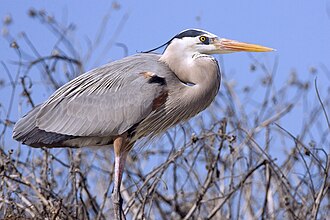Field Guide/Birds/Ardea herodias
| Ardea herodias (Great Blue Heron) | |
|---|---|
| Description | |
| The Great Blue Heron, Ardea herodias, is a wading bird of the heron family, common all over North and Central America as well as the West Indies and the Galápagos Islands, except in deserts and high mountains where there is no water for it to wade in. The Great Blue Heron is the largest heron in North America.
Adults have blue-grey wings and back and a white head with a black cap and a long black plume. The face is white, with a black streak extending from behind the eye to the back of the head. They have a long neck, streaked with white, rust-brown, and black, which is generally held in a s-curve while wading, and a short tail. The beak is yellow, long, and and tapers to a point. Legs are long, and greenish-yellow in color. In flight, the head is held close to and aligned with the body by a downward bend in the long neck. The long legs trail behind. This bird flies with strong deliberate wing beats. The males and females appear relatively similar, but males have a puffy plume of feathers behind their heads, and tend to be slightly larger than females. It is found throughout most of North America, including Alaska, Quebec and Nova Scotia. The range extends south through Florida, Mexico and the Caribbean to South America. Great blue herons can be found in a range of habitats, in fresh and saltwater marshes, mangrove swamps, flooded meadows, rivers, lake edges, or shorelines, but they always live near bodies of water. Generally, they nest in trees or bushes that stand near water. It feeds in shallow water or at the water's edge during both the night and the day, but especially around dawn and dusk. Herons locate their food by sight and generally swallow it whole. Herons have been known to choke on prey that is too large.It uses its long legs to wade through shallow water, and spears fish or frogs with its long, sharp bill. Its diet can also include insects, snakes, turtles, rodents and small birds. It is generally a solitary feeder. Individuals usually forage while standing in water, but will also forage in fields or drop from the air, or a perch, into water. As large wading birds, Great Blue Herons are able to feed in deeper waters, and thus are able to exploit a niche not open to most other heron species. This species usually breeds in colonies, in trees close to lakes or other wetlands; often with other species of herons. These groups are called heronry (more accurately than "rookery"). The size of these colonies may be large, ranging between 5 – 500 nests per colony, with an average of approximately 160 nests per colony. Great Blues build a bulky stick nest, and the female lays three to six pale blue eggs. One brood is raised each year. If the nest is abandoned or destroyed, the female may lay a replacement clutch. Reproduction is negatively affected by human disturbance, particularly during the beginning of nesting. Repeated human intrusion into nesting areas often results in nest failure, with abandonment of eggs or chicks. Both parents feed the young at the nest by regurgitating food. Parent birds have been shown to consume up to 4 times as much food when they are feeding young chicks than when laying or incubating eggs. Eggs are incubated for approximately 28 days and hatch over a period of several days. The first chick to hatch usually becomes more experienced in food handling and aggressive interactions with siblings, and so often grows more quickly than the other chicks. Birds east of the Rocky Mountains in the northern part of their range are bird migratory and winter in Central America or northern South America. From the southern United States southwards and on the Pacific coast, they are year-round residents. | |




